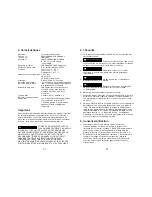
4.2 Alternators and Generators
Set the function/range switch to the 20 volt DC range. While
the engine is idling at normal operating speed, touch the black
(-) test lead to the metal framework of the vehicle, then touch
the red (+) test lead to the output terminal connector. The
alternator output cable is always the heaviest gauge cable
attached to the alternator (see fig. 3). The display should read
12 volts or more. If the display fluctuates rapidly, the cable
may need to be tightened. If the engine is idling lower than is
specified in the vehicle owners manual, the voltage reading
will be lower. If the output voltage is significantly low, the
alternator may require service or replacement.
When making automotive measurements,
observe safety precautions. Stay away from the fan blades,
belts and other moving parts of the engine. Keep the
multitester and its leads away from moving parts.
4.3 Household Batteries
Set the function/range switch to the 20 volt DC setting. Touch
the red (+) lead to the (+) terminal of the battery and the black
(-) lead to the (-) terminal of the battery. Read the voltage level
of the battery on the display. Generally speaking, if a battery’s
output voltage falls below 60% - 70% of its original rating, it
should be replaced.
5. DC 10 Amp Measurement
A separate input jack is provided for measurement of DC
current up to 10 Amps. This range is not fused so it is
imperative that the circuit under test does not exceed 10
Amps. Additionally, this function is designed for intermittent
use only. Maximum contact time of the test leads with the
5
6
Figure 3
meter’s sampling method. This unit samples at a rate of 2
times per second, thus the fluctuation of the readout.
4. DC Voltage Measurement
1) Set the function/range switch to the DC voltage range.
2) If the polarity of the circuit to be tested is known, touch the
black test lead to the neutral side. If the polarity is
unknown, touch the test leads to opposite sides of the
circuit. If the test leads are reversed, the “(-)” indicator will
appear on the display. Reverse the test leads for proper
polarity and read the value indicated on the display.
4.1 Common DC Voltage Measurements
Automotive Batteries
Set the function/range switch to the 20 volt DC setting. First
check the quality of the battery terminal connector by touching
the red (+) test lead to the connector while touching the black
(-) test lead to any bare metal framework of the vehicle. The
tester should read 12 volts or higher with all of the vehicle
accessories turned off. If the display fluctuates rapidly, this
could indicate a bad terminal connection. Remove the
terminal connectors and clean both terminals and connectors
thoroughly. For improved conductivity and corrosion
resistance, coat the terminals and connectors with GB #OX-
100 anti-oxidant compound (available at your local hardware
store). Replace and tighten the terminal connectors. Secondly,
if the terminals and connectors are making good contact,
touch the test leads to the battery and vehicle framework as
described above (see fig. 2). Note the reading of the meter.
Get an assistant to turn on the headlights while the test leads
are making contact. The reading should drop a few volts.
Should the reading drop 5 volts or more, the battery should be
charged or possibly replaced if the voltage drop is significant.
The circuit may need to be checked further for problems within
the electrical system that may be draining the battery.
Figure 2
!
WARNING





































